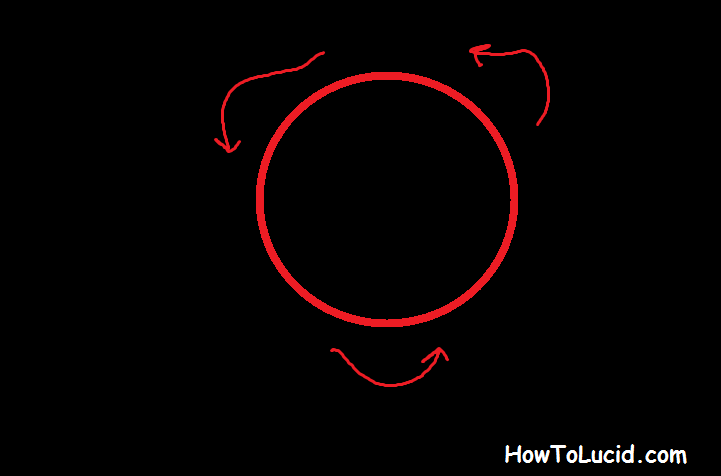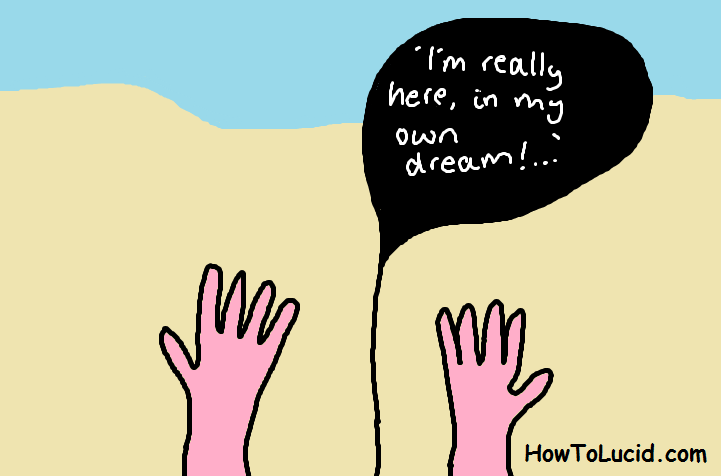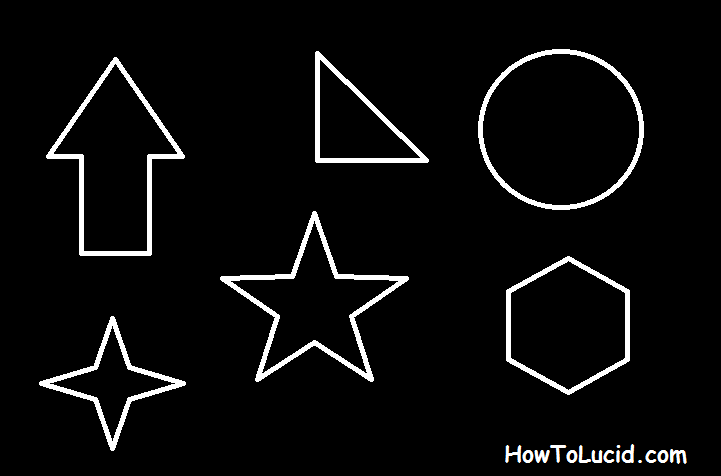The WILD (Wake induced lucid dream) lucid dreaming technique involves keeping your mind awake while your body shuts down and goes to sleep.
It’s a powerful lucid dreaming induction technique, and will let you induce lucid dreams AT WILL whenever you want!
In this article, we’ll learn:
- How to perform the WILD technique (6 step method)
- How to use the WILD alongside other techniques
- Can you do the WILD without sleeping first?
- Bonus tips
Let’s get started…
The basics of this technique are to stay focused, keep concentrating on staying awake, while letting your body go into what is called ‘sleep paralysis’.
This means that you can bypass the need for reality checks by simply not going to sleep in the first place, at least not in your mind. Your body goes to sleep and undergoes what’s best described as being unable to move.
The muscles become paralysed and your temperature drops. You are essentially sleeping, but by remaining focused while you fall asleep, you are able to stay awake in the dream, thus creating and inducing a lucid dream.
It’s a good technique because it encourages you to relax and meditate before sleeping, which you should be doing anyway to promote overall physical and dream/sleep related health.
Let’s begin.
How to perform a WILD
As the name suggests, the WILD lucid dreaming technique involves starting when you’re awake.
Begin about an hour before you go into bed. Read a few articles on Lucid Dreaming, maybe some Lucid Dream stories or dream journal entries.
Go back over your old dream notes in your diary. Make sure that for this hour, you do not eat, drink or look at any digital media, no screens, TVs or phones etc.
This is the hour which you will use to get into a relaxed state, and to relax your mind before trying to sleep. It’s good to read your dream notes though, as this will increase the chances of you spotting a dream sign and recognising something from a previous dream when you fall asleep.
Now that you’re relaxed and you’ve read through some notes, maybe even done a few deep breathing exercises, you’re ready to sleep. Turn off all the lights, reduce any noise in the room to a minimum, and get into bed, making sure that you’re comfortable, and the temperature of the room is at a relaxing level. Not too hot, not too cold.
The 6 stages of WILD lucid dreaming
Here are the steps needed to perform a WILD lucid dream. We’ll cover each one in a lot more detail further on.
- Step 1: Lay down and get comfortable
- Step 2: Relax all your muscles and don’t move
- Step 3: Try and visualize shapes and colours
- Step 4: Keep doing that until you feel yourself fall asleep
- Focus on keeping your MIND awake
- You’re in a lucid dream!
Step 1: Lay down and get comfortable
Lay down in your bed…
Scratch any itches you have, make sure your muscles are stretched out, you have yawned, sorted your pillows out etc, anything you need to do in order to go to sleep, do this now. It’s important because the following steps require you to not move at all! If you move past this point you’ll have to start again.
This is the time also to finally check your room, and ensure lights are all off, nothing is plugged in or making a light/noise. You’re comfortable and relaxed. Try and suppress any thoughts you are having, any worries or memories, just observe them, and let them slip away.
Don’t interact with them, or think about them such as what you’ll do tomorrow, just observe the thoughts, and let them drift away. Think of nothing. It might help to improve your sleep conditions by getting some incense or a decent mattress.
Step 2: The relaxation stage
Now you focus on your muscles. Feel the tension and let it go.
Relax every single part of your body, do it in sections and move all along your body so that every muscle is relaxed, start at your feet, then up through your legs, back, chest, arms, neck and face.
There is a lot of tension held in the jaw and the face which is usually unnoticed, but it’s there. focus on your face and jaw more than the rest of your body, and let go of the tension. You should be completely relaxed and limp, supported only by your mattress.
Step 3: Control your breathing
Now that your muscles are relaxed, you can focus on your breathing, feel the breath go into your mouth and out through your nose, or whichever way is the most comfortable, but make sure you’re breathing deeply and in a fashion which doesn’t make you uncomfortable.
As you’re laying there, feel your heartbeat. Not with your hands on your chest, but rather just try and feel it beating through your chest. You can feel it if you pay attention.
Now try to lower it. This is something which takes practice, so if you can’t lower your heartbeat just by laying there, just move on to the next step. If you are able to do this, lower it to a relaxed rate.
Step 4: Try to visualise and hear sounds
Spend about 10-20 minutes on the last step, making sure you’re totally relaxed and comfortable. This is important for the later stages. Now you’re going to try and ‘see’ images and shapes. Your eyes are closed, and you’re relaxed but you’re going to visualise things.
Start by imagining a circle.

Just a plain ring in front of you. When you can see that circle, make it clearer. Now make it disappear. Get the circle back, and keep bringing shapes up this way and get good at thinking about a shape and then seeing it in front of you.
Now start playing around with it, make it bigger, change the colour, and make it start to move.

Spin the circle round. Now after a while you’ll be able to visualise more complex things, try seeing a beach.
An island in the distance, and you’ll find that as you ‘go with it’ the environment seems to create itself. You need to do less and less, and are now just seeing it create itself.

Decide on a basic setting for the dream, such as a forest or an island, something easy with not a lot of movement, just the waves and the trees swaying in the breeze. Really visualise it and try to see the details, but focus more on ‘seeing’ them than imagining them. Think as though the beach is already there, but you just can’t see it.
Step 5: Insert yourself into the dream environment
Now you start to put yourself and your awareness into that environment. Start by looking around, turn in a circle in your mind, see what’s behind you. Now see if you can look down, do you see your feet? your hands?

Feel the temperature, and listen for the sounds in the background. What do you feel? the sand on your bare feet? Tell yourself that you’re dreaming, and that it’s all in your head. You can now move around, and interact with the world. Your body is asleep but your mind is now creating a world around you.
A note about the illustrations
I know they’re bad, you know they’re bad..
We all know they’re bad, but they serve a purpose. There are about half of you who can’t stand to read loads of text, and for you guys we’ve got the illustrations. Hopefully they’re not SO bad that you can’t understand what I’m trying to say with them, but please understand that I’m not an artist. I only include these little illustrations to explain things to the visually minded of you.
You’re in a lucid dream now!
You’ve just created your Lucid Dream using the WILD technique!
Now you’re in the dream, and you’re semi-lucid, it’s time to start stabilising the dream, maybe do a couple of reality checks, just to make sure, and it’s very important at this stage to keep calm, and not run around yelling ‘I’m Dreaming’, that’s a classic beginner mistake.
And that’s how to perform a Wake initiated lucid dream, or WILD for short.
It does take a lot of practice because it’s not something you’ll be used to and it’s a new skill. When you do perfect it, however, it will allow you to directly induce a lucid dream. Some of my best lucid dreams have come from using the WILD technique.
Can this be used alongside other techniques?
This technique lends itself quite well to a few other things we’ve covered on this site, and that’s because this method requires you to just relax and visualise the dream, so it works great with things like the Cinema technique once you’ve actually induced the lucid dream, and also the meditation methods we’ve covered.
The WILD WBTB technique combination
It’s worth noting that this technique DOES work on its own, as we’ve described here.
You can do the WILD technique on its own just AS you’re going to sleep, but you can ALSO do it combined with another technique called the wake back to bed or the WBTB. Instead of clogging this article up just consider this:
The BEST time to do a WILD is when you’ve already experienced a lot of normal sleep in the night. This is because you’ll be entering the largest stages of REM sleep in the early morning. The WBTB technique shows you how to target that part of the night and perform a WILD at the time of the night when your REM sleep is longest.
Common problems and questions about the WILD
Doing reality checks to stabilize the dream
A large number of people find that when they try the WILD technique, they struggle to do reality checks once they’re in the dream. If you find that you can enter the dream properly but you FAIL to do a reality check, you’re not alone. There are several little things that most people do that means they will always fail at reality checks, unless they change them.
- See my complete reality checks guide for more.
The swallowing or gag reflex during the WILD
Some people report an urge to swallow their saliva or feel like they’re gagging when trying to perform a WILD.
This is normal and it’s because when you start out, relaxing all your muscles while keeping your mind active is a FORCED habit and it doesn’t feel natural. For this reason your neck and jaw muscles are all tensed and feel weird.
Just keep practicing and start focusing on relaxing your muscles around your neck, shoulders and jaw MORE than any other area at first. This should stop you feeling like you need to swallow. If you HAVE to swallow, don’t worry it won’t affect the technique much just don’t keep doing it.
If you’re JUST starting to enter sleep paralysis however, then swallowing will ruin it. Make sure you swallow and make yourself comfortable before you attempt the technique as any movements, swallowing, or thoughts could make it stop working. A very simple way to stop the swallow reflex is laying on your side INSTEAD of your back.
If you can’t fall asleep
People sometimes report not being able to fall asleep when doing the WILD.
That’s fine, and actually fairly normal.
If you TRY to keep yourself awake, which is how the technique works, there’s going to be a lot of times when you just stay awake naturally. It’s all about relaxing your muscles. Try this:
- Make yourself more tired during the day by exercising
- Try doing it in the early morning combined with the WBTB method
- Be patient and keep trying
- Add in meditation to make yourself more relaxed and ready to fall asleep
- Practice doing it in broad daylight AND at night
Is the WILD dangerous?
There’s nothing scary or dangerous about the WILD method except maybe sleep paralysis.
As you try to keep your mind awake, you’ll notice after a while that you can’t move your body. This is actually something that happens every night to all of us, it’s just you don’t notice it most of the time because you’re asleep.
Don’t be scared by that and you’ll be fine. The wake induced technique is not dangerous and in fact it’s one of the most effective and most commonly used or known about techniques out there. Sadly you can’t perform the WILD without experiencing sleep paralysis, because that’s essentially how the method works.
How long does it take to have a WILD?
The wake initiated method takes about 10-30 minutes to complete start to finish, depending of course on how long it normally takes you to fall asleep. It might take slightly less if you try it at about 4AM after having most of your nights sleep (set an alarm to wake you up early). You can keep a journal and write in it which times of night worked best for you.
Doing the WILD faster
I have created a lucid dreaming technique which is very effective, brand new for 2019 actually. It’s called the 90ILD technique and it let’s you lucid dream in 5 minutes or less. Check it out!
Adding meditation into the mix
Meditation is something that REALLY helps you become more aware.
If you meditate every morning and night, you’ll naturally find that lucid dreaming becomes a lot easier. Try a basic meditation technique every morning and you’ll notice that the WILD method is a lot easier and more successful.
If you’re stuck for things to do once you’re IN the dream, and you’re lucid, you’re also not alone. Lots of people find they just don’t know what to do. In fact, one of the most common things people try and do is fly, but that’s also one of the most common problems. You see, flying in a lucid dream can be difficult. Also, watch my video about lucid dreaming with the WILD technique:
Can you do WILD without sleeping first?
The WILD technique is a powerful lucid dreaming technique that anyone can use to get lucid.
But can you do it WITHOUT sleeping first? Can you perform the WILD first thing at night, before even GOING to sleep.
The answer is:
Sometimes. It really depends on how tired you are, and how fast you can fall asleep. Because the entire technique revolves around you going to sleep while your MIND stays awake, it depends on how tired your mind is.
If you can keep your mind awake while you go to sleep, then sure, you can have a WILD without sleeping first. But most people can’t do that, because they’re not tired enough. So they end up just falling asleep and not being ABLE to keep their mind awake that long.
Remember, it takes about 90 minutes to fall asleep and reach REM sleep, when you first go to sleep.
So if you can keep your mind awake and focused for 90 minutes then you CAN have a WILD before sleeping first. But most people can’t, so they wait until the early hours of the morning.
And like we’ve said, in the early hours of the morning, you’re more likely to have a lucid dream. Your REM sleep is longer, and you’re more tired. So falling BACK asleep is so much easier.
Useful tools for the WILD
Here are some other lucid dreaming techniques you might want to try:
- The wake back to bed: A classic technique involving doing the WILD but after you’ve already slept for 5 hours
- The mnemonic induced lucid dream: Using mantras and visualisation to lucid dream randomly
- Dream induced lucid dream: Using the dream itself to make you lucid randomly
- The senses induced lucid dream: Using your senses and awareness to propel yourself into a lucid dreaming state
- The finger induced lucid dream: Using the subtle movement of your fingers to HACK your way into a lucid state
- My 90ILD technique: A combination of the most effective parts of all the other techniques
- Reality checks for lucid dreams: A guide on using reality checks to reliably lucid dream
- Writing your dreams down: How to write your dreams down properly
If you’re really serious about learning to control your dreams and you REALLY want it to happen, you need to build up the HABITS you’ll need to lucid dream. These are very important, and learning the wrong things will mean you’ll waste HOURS.
I created a highly effective step by step Lucid Dreaming BOOTCAMP course that FORCES you to lucid dream. If you don’t lucid dream within 2 weeks, you can get your money back.
Here’s some of what you’ll learn in the bootcamp course:
- Exactly what to practice, which techniques, reality checks, exercises and ideas you should do on specific days for 30 days (and how to do them) so you can just save loads of time
- It’s like I’m taking you by the hand as if I were there coaching you personally (which would cost several hundred dollars and take lots of time). Many students love the bootcamp because it feels like I’m personally helping them do all of this, and making it less confusing!
- Learn why lots of people read lucid dreaming books but can’t ACTUALLY have a lucid dream because they don’t build up the habits they need in the right way. They practice the wrong things that actually stop them being able to lucid dream! (Plus a lot of common lucid dreaming books teach stuff that doesn’t work, you’d be surprised)
- Some simple and effective ways to set up your dream journal properly so you can easily refer back to old dreams, and a simple trick you can use to make sure that you always know what works best for you (Almost no-one does this for some reason)
- The strange but powerful meditation technique you can do to have more lucid dreams every week (and it only takes 30 seconds)
- The most common reality checks and how to do them so you can test whether you’re awake and naturally lucid dream most nights (Even when you’re not putting in much effort, or haven’t been practicing)
- The weird ‘island visualisation’ technique I created to help you drift into a lucid dream much faster than normal, and stay in your lucid dreams for much longer than most people!
- Specific lucid dreaming induction techniques and the BEST way to practice them (This includes the Wake back to bed, The Wake induced lucid dream, the Mnemonic induced lucid dream and lots more, but with my unique TWIST to make them more effective!)
- A way of talking to yourself that will give you lucid dreams and ensures that you KEEP having lucid dreams. It’s almost like you’re training your own brain to have MORE of the experiences you want!
- Exactly WHEN to practice each specific thing! I’ll tell you on each specific day, what techniques, ideas and methods you need to practice or think about on that day to lucid dream. It’s like I’m personally coaching you and making SURE you have a lucid dream!
- And remember, you can do these exercises and techniques in as little as 3-5 minutes per day (Of course, you could spend longer if you want, it’s up to you and how much free time you have, but it can and will work with just 3 minutes per day)
Get the step by step Lucid Dreaming BOOTCAMP course that FORCES you to lucid dream. This will work for you, even if nothing you’ve tried before has worked. Don’t take my word for it, read the huge load of reviews on the page.




